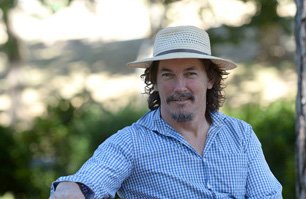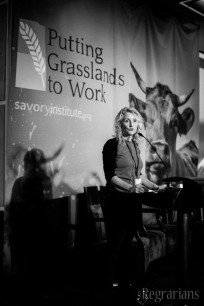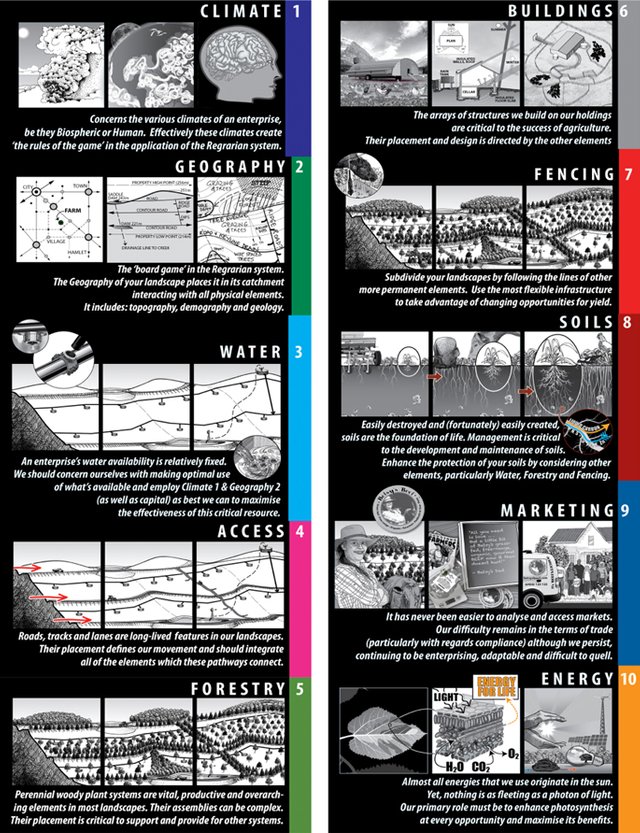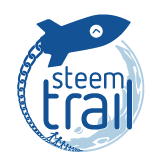HOLISTIC REGENERATION - The Regrarians® Platform - Introduction
Stewardship of land, people, flora and fauna, for mutual awesomeness!

Today I'm introducing a new series based on holistic regenerative agriculture, specifically focused on the Regrarians Platform. Regrarians®, a term coined by Darren Doherty, blends regenerative and agrarians. It may be the single most holistic systematic approach to land management in practice today.
The Regrarians® Platform is the basis of work flow & decision-making for all of Regrarians Ltd. work in designing, developing & training in the field of Regenerative Agriculture & Living. The Regrarians Platform is based on the ‘Keyline Scale of Permanence’ developed by the late, great Australian agricultural landscape designer, P.A. Yeomans as outlined in his 1958 classic, ‘The Challenge of Landscape’.
There’s a temptation when introducing a series to try to tick all the boxes in one shot. Of course, that would negate the need for a series. But it also would do readers a disservice, if for no other reason than the fact that the task is impossible. At the very least, it would be incredibly cumbersome in this format.
So, let’s go with some introductions. We’ll answer a few of the basic questions, such as: Who is Joe? What is holistic regeneration? What are we gonna do here?
Who’s Joe?

in Santiago de Chile
Another temptation is to lay things out like a resume, trying to make myself look better than I am. It’s probably safe to say that I’m the quintessential quinquagenarian who is constantly striving to figure out what he wants to be when he grows up.
A couple of months ago I posted an @introducemyself, so there's no sense doing that here. But it might be a bit helpful to provide some background as to why I would have any credibility in holistic regenerative agrarian pursuits or education.
I’ve done a few things, being a sort of Jack of several trades and master of a couple. It’s probably safe to say that I’m somewhat career averse. I enjoy learning and experiencing new things, so I’ve gravitated from one job to another, for various reasons. Usually circumstances changed, so I had to look for work. Rather than sticking with what I’d been doing, I attempted to pick something else up. As a result I’ve worked in various jobs, some unrelated. But, as I look back on them, I can see that they’ve all conspired together to provide the ability and insight I have today. Here’s a list of most of them:
Concrete crew; airline ground operations supervisor; fencing contractor (mostly horse applications); electrician, tractor mechanic, pastor, writer, web design (front end), consultant, knucklehead and smart alek.
In the last few years I’ve become more focused on regenerating the land, specifically for agricultural purposes. As I grew in my understanding of permaculture, I became both excited and frustrated at the same time. Excitement came as I grew to understand the microbiological systems that could be promoted by taking a holistic approach. Frustration came as I realized that the system is rigged in favor of the industrial monoculture farm, and that a more holistic pursuit seemed to offer far greater challenges in being financially sustainable.


The big evolution in the Regrarians Platform over Yeomans’ Keyline Scale of Permanence is its inclusion of social & economic themes, whereas Yeomans scale was very much centred on agriculture. The Regrarians Platform also has changes in some of the headings and adds 9. Economy & 10. Energy to Yeomans original eight headings.
What is Holistic Regeneration?
I’m really glad you asked. Holistic regeneration focuses on two main aspects of land design and management:
- One is our need to take all things into consideration in a logical (though sometimes flexible) order.
- The other is that our goal is to design in such a way that the land and systems are not merely sustainable, and certainly not degenerative (like so much of our farmland and even rangeland is), but regenerative. In other words, they are constantly improving and growing in their health and productive capacity.
The holistic perspective specifically focuses on the scale of permanence. This “scale of permanence” addresses the inputs and structure of the land beginning with that which is most difficult, if not impossible, to change and ending with that which is less permanent and/or most easily changed. While we can, to at least some degree, affect them all, some are affected very little by our efforts while others are almost absolutely affected. Also, some of our efforts will stand the test of time, while others will need our constant attention and maintenance.
Regrarians Ltd. Statement of Purpose
…’Regrarian’, a portmanteau of ‘Regenerative Agrarian’, is a term first coined by Darren J Doherty in 2013 to describe those who are actively undertaking the serious & timely process of regenerating, restoring, rehabilitating, rekindling and rebooting production landscapes, be they urban or rural, across the world.
The primary directive of Regrarians Limited entity is to the regenerative enhancement of the biosphere’s ecosystem processes. The secondary directive of Regrarians Limited is to internationally provide the potential for people to be informed about the regenerative economy by the delivery of extension, media, education, goods & materials, whether it involves their work in primary production, other themes of land management, extractive industries, corporate life, domestic services, manufacturing and other activities that are within the reasonable domain of humans — and to undertake and pursue all such other similar, related or compatible objects as may from time to time be considered appropriate by the Company…
We’ll dig into these further over the course of time, but here’s the list according to the Regrarian Platform. We’ll borrow from Darren’s definitions in order to avoid reinventing the wheel.
- CLIMATE – You, Enterprise, Risk, Weather
- GEOGRAPHY – Landform, Components, Proximity
- WATER – Storage, Harvesting, Reticulation
- ACCESS – Roads, Tracks, Trails, Markets, Utilities, People
- FORESTRY – Blocks, Shelter, Savannah, Orchards, Natural
- BUILDINGS – Homes, Sheds, Portable, Yards
- FENCING – Permanent, Electric, Cross, Living
- SOILS – Planned Grazing, Minerals, Fertility, Crops
- ECONOMY – Analysis, Strategy, Value Chain
- ENERGY – Photosynthesis, Generation, Storage
As noted above, regeneration does not settle for the status quo. Mere sustainability falls short of the goal. Regeneration focuses on building the most healthy and dynamic system/s possible. In arid regions this can be most challenging. More temperate and wetter climates are more forgiving and resilient.
Our goal is to build up the land’s organic systems in such a way that each of these items on the Regrarians Platform becomes a tool in our arsenal, promoting the health of the land and animals, the durability of the structure/s and the well-being of the people. Each of these should be in a constant state of improving/regenerating, building upon and complementing one another, never settling for mere sustainability.
What are We Gonna do here?
The sky is really the limit, within the bounds of holistic regeneration. We could call it holistic agrarianism or regenerative agriculture. All of these would be just as readily applicable.
We’ll look at aspects of the Regrarians Platform and discuss why it’s laid out in the order that it is. Each theme will be examined and discussed. In doing so, we’ll explore techniques, various possibilities, tools of the trade, perspectives and anything else applicable to our desire to promote the regenerative capacity of our project/s. In doing so, you’ll learn more about both yourself and how to interact with the land, plants, animals and people around you. You’ll start thinking differently. And you’ll become more effective in your efforts to have a positive influence on the lives you touch, whether they’re microbial, mammalian or somewhere in-between.
My goal will be to provide at least one article a week focused on a specific theme of the Regrarians Platform, in order of permanence. Why permanence? Mainly, because it focuses on the longest-term aspects of the design because it's what we can least effect, therefore other aspects need to conform to those that are more permanent.
A Caveat
I've been blessed with being able to spend a fair amount of time with Darren and Lisa. They're great people and I consider myself privileged to consider them dear friends. During the past year I've attended his ten day training three times, writing articles and providing pictures for them to use in their promotions. However, while knowledgeable about the Regrarians Platform, I hesitate to call myself an expert. This is because my experience in implementing it is minimal. As Darren pointed out regarding my writing, it is my perspective on it and sometimes may stray from his own. Where that is the case, I do so accidentally and bow before his extensive experience and expertise.

An Appetizer
I’ll close with a little tidbit related to our first theme, #Climate. Our first inclination is to think about the weather patterns. But there’s more to it - much more. The most important climate when it comes to stewardship of the land and its biology is the climate between your ears. It’s not necessarily that it needs to change (though it might) so much as that it needs to be recognized for what it is.
Weaknesses, desires, strengths, competencies, etc., all must be examined in a realistic way so that any decisions can utilize or compensate for them accordingly. Any failure here will tend to magnify issues later. And this is doubly so if there are relational challenges that affect your land management.
While the rules of the game are largely determined by many circumstances out of your control, your mind can set the stage and change the rules to some degree too. And you may find that this is the most challenging theme to manage. However, the rewards for rightly assessing and working within your own climate are great indeed.
Feel free to contact me in chat if you desire to discuss your project. If you're interested in hiring Darren to design your project, you can find details here.
Steemin' on,
Another Joe

Logo courtesy of @oecp85



Upvoted by @gardening-trail
Join us in the steemtrail chat channel
Read our full guidelines here
Thanks Steem-Trail!
This should be good, Joe. Wondering if you are familiar with a project out of Salina, Kansas called The Land Institute. I remember reading an article (maybe in the Atlantic) many years ago that discussed Wes Jackson's work, and I followed them casually through a newsletter and other material they sent me, but I lost track at some point. I'm very interested in the topic of responsible stewardship of the land and other natural resources.
Thanks @thylbom,
I've heard of The Land Institute, but am not familiar with them. We did do an open consult/workshop in western Kansas, but I don't recall if the landowner mentioned them either. He's pretty proactive in denouncing the cronyism of the cattle industry. I'm sure he knows about them.
I'm really looking forward to this series joe!
I'm looking forward to your series! There have been so many great folks working on regenerative agriculture over the years. I always liked the work of the Rodale Institute because they did a lot of experimenting and testing. And they viewed actively participating in regeneration of damaged systems as a way balance out a lot of the negative things that we hear all the time. It helps us, too, not just the land.
You mentioned the difficulty in dealing with arid lands systems. That's a challenge, for sure. The Malpais Borderlands Group in the US Southwest is pretty successful in my view, on a large landscape scale and integrating ranching. Regenerate! : )
Thank you. Yeah, they ring a bell. I'm in AZ and see a lot of the challenge. Unfortunately, few in our area recognize now much they can change the landscape through holistic design. Overgrazing and destruction of soil nutrients continue to be the norm. We see pioneer species such as creosote overwhelming what used to be fairly productive land, in spite of being desert.
I'll have to look further into The Malpais Borderlands Group. Thanks again.
It doesn't help that the groundwater tables have been sucked so far down, either. In Tucson, Brad Lancaster has done a lot with rainwater harvesting. Tucson has some pretty cool ordinances that promote rainwater harvesting, too. Best of luck in your regeneration, too!
You know Brad? He's a great guy, isn't he? He's done some amazing work. I got to spend some time with him last year, along with Art Ludwig. Art's place is amazing. He catches thousands of gallons from storm events.
We're working on our own harvesting too. So far I am not storing the runoff in cisterns, but have developed my yard so that no water that lands on my property leaves it. A couple of flood areas are now more efficient water harvesting areas too.
I'm looking forward to your digging report and your curb cut, too. Dig on! :D
Guerrilla curb cuts, on their way! That's how Tucson started. People were doing it on their own, in the middle of the night. So the city had their Dept. Transportation look at them and make some standard designs. Now, real contractors can do this, on the up and up, for anyone. Good luck in working with your city.
Yeah, I'll do it when the structure is there. But I have a lot of digging to make it worthwhile first. But we get HUGE flow when it rains here, so I'll be able to do get a nice swath soaking up runoff. And I already have co-conspirators to help with the curb-cut. :P
That's great! Yeah, Brad does pretty great work. Tucson Water didn't trust their water meters with his house, because he wasn't using any water. It's great if you don't have any runoff. Keep in onsite. Now folks are putting in the curb cuts and little street dams to get the street runoff into their landscaping, haha.
I have a design for a couple of curb cuts here. I tried to get the city to participate, but they don't want to. It's in the middle of a long list of things to do. :)
Greets Joe, holistic, mutual awesomeness sounds perfect to me! We have a lot in common. I'm following you now.
I found you because I am investing a lot here in the form of technical knowledge, time, creativity and tech hardware as I am now a witness for Steem and I noticed that you are voting for @tdv.witness - but that tdv's witness server is offline and of no use to Steem (for quite a long time as far as I can tell).
I would really appreciate if you would support me with a vote to give me a chance to show what I can do for Steem and Steemit. I have a long background in software engineering and also in running social networks.
My witness application post is here.